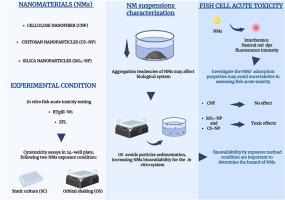Exploring the applicability of the RTgill-W1 and ZFL cell line assays in aquatic hazard assessment of mineral and organic nanomaterials
IF 8.1
2区 环境科学与生态学
Q1 ENVIRONMENTAL SCIENCES
引用次数: 0
Abstract
Many fish have been used annually to evaluate chemical hazards to aquatic environments; thus, cell-based methods, such as the RTgill-W1 and ZFL cell line assays, have been proposed as alternatives to provide information on acute toxicity to fish, mostly in screening approaches and as part of a weight of evidence (WoE) approach. These methods have been developed using soluble chemicals, which can pose challenges for testing novel types of chemicals, such as nanomaterials. Cellulose nanofiber (CNF) kraft-bleached pulp, chitosan nanoparticles (CS-NP), and silica nanoparticles (SiO2-NP) were evaluated regarding their toxicity to fish cells using the RTgill-W1 and ZFL cell line assays (in vitro). Experiments were performed using the original protocols of each assay and modified versions to enhance the bioavailability of nanoparticles (NPs) during in vitro testing. NPs characterization in the exposure media (mean diameter, polydispersity index) was also performed. Both cell lines were exposed to CNF (39–1250 mg/L), CS-NP (4.88 mg/L to 156.25 mg/L), and SiO2-NP (7.81 mg/L to 250 mg/L) for 24 h under static culture (original protocols) and orbital shaking at 150 rpm (modified protocols). Fish cell acute toxicity was determined based on cell viability readouts. There was no effect on cell viability for CNF in both cell lines, while SiO2-NP and CS-NP presented toxicity. The toxic effect levels of SiO2-NP and CS-NP were higher in the static culture than in the orbital shaking. For SiO2-NP, ZFL cells showed higher sensitivity to SiO2-NP toxicity than RTgill-W1; however, the in vitro data did not correlate with the available acute fish toxicity data (in vivo), and if these data were used for classification purposes under the United Nations' Globally Harmonized System of Classification and Labelling of Chemicals (UN GHS), this could lead to overprotective measurements. The NP characterization data demonstrated that all tested NPs exhibit higher aggregation tendencies, which helps explain the observed biological effects. Overall, these results underscore the need for improved in vitro methods to assess the toxicity of NPs to fish cells as well as provide insights into the toxicity of NPs to fish cells.

探讨RTgill-W1和ZFL细胞系测定在水中矿物和有机纳米材料危害评价中的适用性
每年都使用许多鱼类来评估化学品对水生环境的危害;因此,基于细胞的方法,如RTgill-W1和ZFL细胞系测定,已被提议作为提供对鱼类急性毒性信息的替代方法,主要用于筛选方法和作为证据权重(WoE)方法的一部分。这些方法是使用可溶性化学物质开发的,这可能给测试新型化学物质(如纳米材料)带来挑战。利用RTgill-W1和ZFL细胞系体外实验,评估了纤维素纳米纤维(CNF)、壳聚糖纳米颗粒(CS-NP)和二氧化硅纳米颗粒(SiO2-NP)对鱼细胞的毒性。实验采用每个实验的原始方案和修改版本进行,以提高纳米颗粒(NPs)在体外测试中的生物利用度。还进行了暴露介质中NPs的表征(平均直径,多分散性指数)。两株细胞系分别暴露于CNF (39-1250 mg/L)、CS-NP (4.88 mg/L至156.25 mg/L)和SiO2-NP (7.81 mg/L至250 mg/L)中24小时,静培养(原始方案)和150 rpm轨道震动(修改方案)。根据细胞活力读数确定鱼细胞的急性毒性。CNF对两种细胞系的细胞活力均无影响,而SiO2-NP和CS-NP均有毒性。静态培养中SiO2-NP和CS-NP的毒性作用水平高于摇轨培养。对于SiO2-NP, ZFL细胞对SiO2-NP毒性的敏感性高于RTgill-W1;然而,体外数据与现有的鱼类急性毒性(体内)数据不相关,如果这些数据用于联合国全球化学品统一分类和标签制度(UN GHS)下的分类目的,这可能导致过度保护措施。NP表征数据表明,所有测试的NP均表现出较高的聚集倾向,这有助于解释观察到的生物学效应。总的来说,这些结果强调需要改进体外方法来评估NPs对鱼细胞的毒性,并为NPs对鱼细胞的毒性提供见解。
本文章由计算机程序翻译,如有差异,请以英文原文为准。
求助全文
约1分钟内获得全文
求助全文
来源期刊

Chemosphere
环境科学-环境科学
CiteScore
15.80
自引率
8.00%
发文量
4975
审稿时长
3.4 months
期刊介绍:
Chemosphere, being an international multidisciplinary journal, is dedicated to publishing original communications and review articles on chemicals in the environment. The scope covers a wide range of topics, including the identification, quantification, behavior, fate, toxicology, treatment, and remediation of chemicals in the bio-, hydro-, litho-, and atmosphere, ensuring the broad dissemination of research in this field.
 求助内容:
求助内容: 应助结果提醒方式:
应助结果提醒方式:


